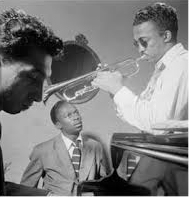If you're a fan of jazzleadsheets.com, you're probably a fan of Rudy Van Gelder, the engineer who recorded most of the early Blue Note and Prestige catalogs, along with many other great albums. Here's something you might like to know about: a radio show dedicated to his work.
“Rudy’s Place”
Sundays 10:00pm to 1:00am Eastern Standard Time
Broadcast over Internet Radio which is heard worldwide. Listeners type WFDU.FM into their browser and click on HD2 "Jazz and What's More." See the end of this article for more ways to hear it.
Nick Scheuble hosts “Rudy’s Place,” a jazz show dedicated to playing music recorded by the most famous engineer in jazz history, Rudy Van Gelder, whose legendary studio is nearby in Englewood Cliffs, New Jersey.
Van Gelder’s career has spanned over 6 decades, recording Jazz icons such as John Coltrane, Miles Davis, Herbie Hancock and Thelonious Monk; for labels such as Blue Note, Prestige, Impulse and others. He is the engineer who recorded Coltrane's “A Love Supreme,” Oliver Nelson's “Blues and the Abstract Truth,” Wayne Shorter's “Speak No Evil,” Wes Montgomery's “Smokin' at the Half Note” and countless other masterpieces. His name on a recording is a bonafide jazz “seal of approval.”
Your host Nick Scheuble is a professional jazz drummer who has performed with artists such as Wynton Marsalis, Wycliffe Gordon, Steve Turre and Bill Crow. In the fall of 2013, Rudy Van Gelder recorded his daughter Leonieke Scheuble’s album entitled, “Debut.” Nick drummed on half the record and Jimmy Cobb (drummer on Miles Davis’ "Kind of Blue") drummed on the other half.
The magic of Rudy’s studio--Rudy saying “Those are the steps where John Coltrane sat after he recorded 'A Love Supreme'” and hearing “The Old Girl,” (the organ that Jimmy Smith played on those historic Blue Note sides), along with Rudy’s genius--inspired the concept for this show.
From his first recordings for Blue Note in 1952, through his most current recordings, be prepared to hear the very best in Jazz through the mastery of Rudy Van Gelder. Tune into “Rudy’s Place” Sundays at 10:00 p.m.
Please visit Nick’s website at www.nickscheuble.com.
WFDU(FM) is owned and operated by Fairleigh Dickinson University
Ways to hear the program:
-- Listening live: WFDUHD2 Sundays at 10 pm Eastern time US (for this method, you need an HD2 or internet radio--some modern cars have these).
-- The next way is to type WFDU.FM in your browser (on your computer) and click the HD2 icon. Again, this is done live Sunday's at 10pm Eastern time and can be accessed anywhere in the world.
-- The last way is the access archives so you can hear the broadcast any time of the day or night. In your browser, type WFDU2.streamrewind.com. Once there, select a "Sunday" and click on "Rudy's Place."
If anyone wants to tell Rudy how his work has affected your life, send a short email to don@secondfloormusic.com.

